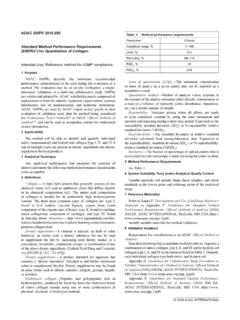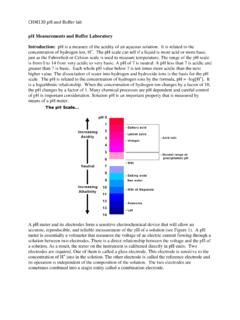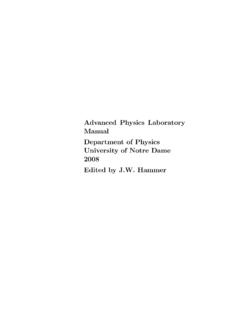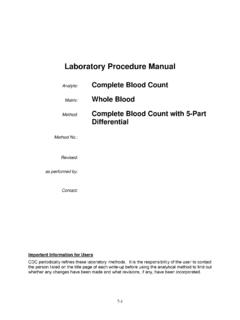Transcription of AOAC Guidelines for Single Laboratory
1 aoac Guidelines for Single Laboratory Validation of Chemical Methods for Dietary Supplements and Botanicals CONTENTS. Introduction Definitions Validation Method of analysis Performance characteristics of a method of analysis Single - Laboratory Validation Work Preparation of the Laboratory Sample Identification Method of Analysis or Protocol Optimization Reference standard Ruggedness Trial Specific variables a. Analyte addition b. Reextraction of the extracted residue c. Comparison with different solvents d. Comparison with results from a different procedure e. System Suitability Checks Performance Characteristics Applicability Selectivity Calibration External Standard Method Internal Standard Method Standard Addition Method Reliability Characteristics Accuracy Repeatability Precision (sr, RSDr). Measurement Uncertainty Reproducibility Precision (sR, RSDR). Intermediate Precision Limit of Determination Reporting Low-level Values Dichotomous Reporting Controls Control Charts Injection Controls Duplicate Controls Confirmation of Analyte 1 2002-12-19.
2 Report (as applicable). Identity, source, purity of reference material Scope, applicability, nonapplicability Recovery, levels, percent (n = 5 at each concentration level). Repeatability, RSDr (n = 5 at each concentration level). Intermediate precision, RSDi (n = 5 at each concentration level). Limit of determination Because of the time and expense required for the determination of modern analytes such as pesticide residues, industrial contaminants, veterinary drugs, allergens, botanicals, dietary supplements, and alternative medicines in complex matrices, there is considerable interest in obtaining acceptable methods of analysis faster and cheaper. It has been suggested that accreditation of laboratories, internal quality control, and external proficiency exercises can improve Laboratory performance to the point where interlaboratory validation is no longer an absolute necessity. To this end AOACI has been exploring alternatives to the full interlaboratory study design that requires the examination of a minimum of 5 matrices by 8 laboratories (see under method validation programs).
3 These have included minicollaborative studies that reduced the required number of matrices and laboratories, the Peer-Verified Methods Program which merely required verification of the analytical parameters by a second Laboratory , Performance Tested Methods for test kits, the developing e-CAM compiling program ( ), and the International Union of Pure and Applied Chemistry (IUPAC) sanctioned Single Laboratory validation protocol (Pure & Appl. Chem. 74(5), 835-855(2002). The IUPAC Single - Laboratory protocol necessarily deals in generalities and specifically points out, The total cost to the analytical community of validating a specific method through a collaborative trial and then verifying its performance attributes in the laboratories wishing to use it, is frequently less than when many laboratories all independently undertake Single - Laboratory validation of the same method. The protocol also indicates that the degree of validation depends upon the status of the method in the analytical structure.)
4 At one extreme is the initial application of a well-established method in a Laboratory that merely requires verification of the capability of that Laboratory to achieve the published performance characteristics. The opposite extreme is the initial presentation of a new method or the initial application of an established method to a new matrix or application. Methods that are developed in response to a continued need for compliance, surveillance, and enforcement of laws and contracts involving a number of laboratories are expected to proceed to a multilaboratory validated status. This AOACI document is intended to present Guidelines for the evaluation of the initial use of a new or old method in a Laboratory . It assumes that a proposed or 2 2002-12-19. available method is fairly well developed, optimized, and stabilized, that it has been applied to some practical test samples with acceptable results, and that a description of the method and its initial performance results are available in some kind of document.
5 The initiating or another Laboratory must then decide if the demonstrated performance appears to be satisfactory for the same or for another purpose. Although the output from method development is the input to method validation, method developers cannot expect much input from method validators. Although method validators may have had considerable experience in the analysis of practical analytical samples, they are not expected to have the basic knowledge to recommend improvement in methods, such as certain solvents as useful for extraction of certain classes of analytes or column-solvent combinations as useful for optimization of separations. Method developers are expected to bring methods to the point where they satisfy validation requirements. By definition, Single - Laboratory validation does not provide any information on what values would be expected on examination of identical test samples by other laboratories. Therefore such methods probably would be used by regulatory agencies only for monitoring purposes to explore compliance with laws and regulations unless the statutes under which they operate assign correctness to their results.
6 Ordinarily such methods would not be used to bring a legal action or to settle a commercial dispute until their properties had been further explored in an environment provided by an interlaboratory collaborative study or a proficiency study utilizing that method. As stated in the FDA Center for Drug Evaluation and Research (CDER) Reviewer Guidance/Validation of Chromatographic Methods (November 1994), Methods should be reproducible when used by other analysts, on other equivalent equipment, on other days and locations, and throughout the life of the drug product.. Introduction The primary purpose of validating a method of analysis is to show that the method is fit for its intended purpose. Some purposes are: 1. Determine how much of a valuable, necessary, or characteristic ingredient is present in a product. 2. Determine if a product meets specifications. 3. Determine if a product meets regulatory requirements. 4. Survey an environment to determine the presence and amount of a component, contaminant, or a nutrient.
7 5. Identify a product and/or its components. The purposes usually answer the questions, What is this product? in the sense of its common or usual name, chemical identity, or components, and How much of something [an analyte] is in this product [matrix]? . 3 2002-12-19. At least at the initial stages of a problem, only a Single or at most a very few laboratories require validation of a method of analysis. These circumstances include situations similar to the following: 1. Methods for research. 2. Only a few test samples are anticipated. 3. For quality control of a manufacturing process of a Single item by a Single producer, 4. Checking the reliability of a method imported from another source. 5. Rechecking the reliability of a previously used method after a period of disuse. 6. Situations where there is a lack of interest by other laboratories in participating in an interlaboratory validation exercise. 7. Multi-analyte, multi-matrix methods where a conventional interlaboratory validation exercise is impractical.
8 For the present purpose we assume: 1. We know or can assume the chemical identity of the material we are dealing with. 2. We have a specimen of the material that can be used as a reference to compare the signal produced by the analyte isolated from the product we are examining with the same signal produced by a known amount of the reference analyte (traceable to a stated reference). If either or both of these requirement are not met, much useful information can still be obtained, but our information will be floating in the same sense as a ship at sea does not know where it is without landmarks to determine its position. If the identity of an analyte must be determined, not merely verified, a whole new dimension is added to the problem. This involves bringing in a Laboratory or an individual with skill in determining chemical structure, a highly specialized, expensive, and time-consuming exercise. It is often found during the initial experience with application or validation of a method that deficiencies appear, unexpected interferences emerge, reagents and equipment are no longer available, instruments must be modified, and other unanticipated problems require returning the method to a development phase.
9 Frequently a method that functions satisfactorily in one Laboratory fails to operate in the same manner in another. Often there is no clear-cut differentiation between development and validation and the two procedures constitute an iterative process. For that reason some aspects of method development that provide an insight into method performance, such as ruggedness, are included in this document. In some cases it is impossible to set specific requirements because of unknown factors or incomplete knowledge. In such cases it is best to accept whatever information is generated during development and validation and rely upon the improvements that are usually forthcoming to asymptotically approach 4 2002-12-19. performance parameters developed for other analytes in the same or in a similar class. Definitions Validation is the process of demonstrating or confirming the performance characteristics of a method of analysis. This process of validation is separate from the question of acceptability or the magnitude of the limits of the characteristics examined, which are determined by the purpose of the application.
10 Validation applies to a specific operator, Laboratory , and equipment utilizing the method over a reasonable concentration range and period of time. Typically the validation of a chemical method of analysis results in the specification of various aspects of reliability and applicability. Validation is a time-consuming process and should be performed only after the method has been optimized and stabilized because subsequent changes will require revalidation. The stability of the validation must also be verified by periodic examination of a stable reference material. The method of analysis is the detailed set of directions, from the preparation of the test sample to the reporting of the results that must be followed exactly for the results to be accepted for the stated purpose. The term method of analysis is sometimes assigned to the technique, , liquid chromatography or atomic absorption spectrometry, in which case the set of specific directions is referred to as the protocol.













